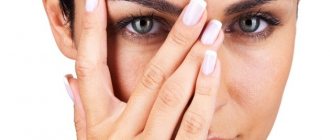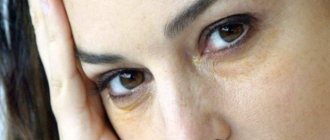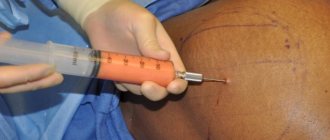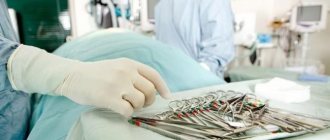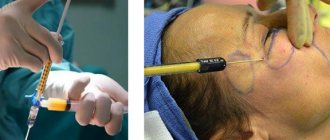Lipofilling of the areas around the eyes is an injection of the patient’s own fat tissue into the area of the lower or upper eyelid. Using this procedure, you can shape the desired eye shape, correct age-related changes, and mask the consequences of injuries. Lipofilling of the upper and lower eyelids consistently receives positive feedback from patients and doctors, since the technique is low-traumatic, does not require work with a scalpel, and the injected fat takes root well due to its complete biological compatibility.
Why complications occur during eyelid lipofilling and how to avoid them
Work on the eyelid lipofilling method in order to obtain an “ideal” result is still ongoing. Such a feature as the unpredictability of the engraftment of fat autograft is not so significant today. But we pay special attention to the issue of the volume of one-time injection of fat.
World expert in the field of lipofilling, Doctor of Medical Sciences David Rubenovich Grishkyan says:
“Why do I consider this question to be the main one in obtaining the desired result in rejuvenating the lower eyelids? The widespread use of eyelid lipofling as a method of rejuvenating the periorbital area is hampered by the imperfection of the technology for introducing fatty autograft. It is known that the relative, at first glance, simplicity of the technique can play a “wicked joke” on the surgeon, leading to complications. But the complication of lipofilling can only be corrected surgically. »
Fat injection techniques for eyelid lipofilling
As a rule, when carrying out lipofilling, two main techniques are used. The first is the so-called “spraying” method. With this method, a small amount of fat is injected into a specific area using dozens of small strokes.
The second technique is the linear insertion technique. In our opinion, the first technique has a number of disadvantages. – Numerous movements of the cannula cause tissue injury. – Tissue swelling may interfere with the analysis of the results obtained. – It is difficult to control the volume of injection, especially if the surgeon does not have sufficient experience in performing the operation. – As a rule, the introduction of fat with this technique occurs when the cannula moves forward, which is fraught with complications. In his daily practice, surgeon D.R. Grishkyan uses the technique of slow retrograde linear injection of fat autograft. This technique allows you to carefully control the volume, layers and area of fat injection, avoiding overcorrection and vascular injury.
Multi-layering as a principle for introducing fat
The next point is the principle of introducing fat. An important factor is layering. We do not inject fat like a regular filler, but place the graft layer by layer according to the principle of building a pyramid. In this case, it is important from which layer to start adding fat. As a rule, we begin the introduction from the deep layers and then move higher to the skin. However, in some cases it is recommended to start the introduction from the superficial layers. The main choice of layer is the thickness of the leather.
Volume of administration
To correct the periorbital area, we introduce the volume of fat implant that we consider necessary. But the main thing that needs to be taken into account when mentioning the volume of injected fat is the size of the fat autograft . In our practice, we use fat implants of the smallest possible size, and it was the reduction in the size of the injected fat tissue and the combination of techniques that allowed us to increase the volume of injection, avoiding complications
LiveInternetLiveInternet
Cucumbers, potatoes, tea bags for the eyes in the morning... Nothing helps? All the same, your colleagues ask you the question every day: “Didn’t you get enough sleep?” Then pay attention to lipofilling.
In a nutshell, lipofilling is filling the voids under the eyes with the patient’s own fat. This procedure is a good solution for those with very thin skin under the eyes, which is why they are not suitable for the usual braces or gold threads.
Another advantage of the procedure is the filler itself, which is the patient’s own fat. And this is an ideal filler, because the fat is native, it is not rejected, and will calmly “live” for the rest of its life, just in a new place.
What is lipofilling?
Lipofilling procedure
Lipofilling takes place in two stages. The first is fat sampling (scientifically, lipoaspiration). As a rule, for facial procedures fat is taken from the knee area. It turns out that in this area the fat is the smallest and best suited for the face.
Fat is removed using a microcannula - a small, thin needle with holes. The smaller the holes on the needle, the smaller the fat cell that is removed.
But it’s too early to transfer fat in its pure form to the face. Before this, it is prepared in a special way. Biomass enriched with platelet autoplasma is added to the fat. This allows you to turn on rejuvenation mechanisms, so that after lipofilling the effect of tightened skin is not temporary, but the skin itself becomes better and tightens.
The second stage is the direct introduction of the resulting enriched fat into problem areas. Fat is injected with even thinner needles (microcannulas). A good surgeon at this stage will not damage a single vessel or nerve; the puncture is done very carefully and the needle is inserted extremely delicately.
Does it hurt or not?
This is one of the main questions that worries a woman who has decided to have surgery. And it is worth reassuring many. The procedure is performed under general anesthesia, which means the patient does not feel anything at all. Naturally, you should choose a good clinic, where a competent anesthesiologist will work, and samples will also be taken for allergic reactions to drugs.
As a rule, there should be no discomfort immediately after surgery, except for a slight lethargy after recovery from anesthesia.
Rehabilitation period
The second question, and an important one for patients: “Will I be able to immediately begin my normal life?” Here a lot is decided by the individual characteristics of the body. Some even refuse to rest after surgery. But the general indications are as follows. Immediately after the procedure, it is better to spend the night in the clinic in order to be under the supervision of professionals while you recover from anesthesia. But after 12 hours you can return home. For some time (several days), the face will be slightly swollen, the bridge of the nose will be noticeably widened. But after a week or a week and a half, you can go to work, see friends, colleagues, and loved ones. People around you will only notice a refreshed appearance, and no one will ever ask about a sleepless night or an unsuccessful party.
Stellar experience
The lipofilling procedure is not a secret for many stars. They share their experience in this area, and even advise their fans to take it. For example, the lead singer of the group “City 312” Aya did this. The singer honestly told her fans that she went for lipofilling. “Dark circles under the eyes are a feature of my body. Which tormented me all my life. I had to put on makeup for an hour to hide them.” That is why Aya decided to undergo lipofilling.
And now Aya calmly prepares before concerts, singing in the dressing room, and not applying layers of makeup. Moreover, the star says that lipofilling turned out to be a very easy procedure for her, because already a week and a half after the operation she performed at a concert in Kyiv.
Lipofilling in action
Surely, you have already realized that the procedure of filling voids with fat can be useful not only in the field of correcting the area around the eyes. Lipofilling is successfully used to fill any wrinkles on the face (special effects are achieved when filling nasolabial folds), lip augmentation, and even to correct the contours of the figure. For example, improving breast elasticity and a slight increase in volume using injections of your own fat is a safer procedure compared to artificial implants.
It only remains to warn you that high-quality lipofilling can only be done in good salons with a proven reputation. Therefore, the cost of the procedure is often high. The price depends on the size of the area where lipofilling is used and the star rating of the clinic. In Moscow, the price for lipofilling starts from 15 thousand and can reach 100 thousand or more rubles.
Article source: mycharm.ru
Lipofilling of the upper eyelids
Loss of volume in the upper eyelid region causes drooping of the lateral edge of the eyebrow and eyelid, creating the appearance of excess skin and ptosis of the upper eyelid.
The main indication for surgery is
- Skeletonization of the upper eyelid
- Age-related skeletonization of the upper eyelid caused by atrophy or migration of adipose tissue
- Skeletonization of the eyelid associated with the anatomical features and structure of the eyes
- Skeletonization resulting from excessive fat removal during upper eyelid surgery
In this case, lipofilling made it possible to correct the skeletonization and asymmetry of the upper eyelids.
When diagnosing a patient’s face before surgery, we perform a comprehensive analysis of the entire upper third of the face. By performing lipofilling of the upper eyelid, we are able to restore the volume. Sometimes we perform this procedure in combination with a lateral brow lift. This allows you to return the eyebrow to the correct anatomical position, and thereby solve the problem of excess skin of the upper eyelid, without resorting to traditional blepharoplasty.
In young patients under 40 years of age, in the absence of significant excess skin of the upper eyelid, this method gives significant aesthetic results. Lipofilling of the upper eyelid goes well with such rejuvenating operations as upper eyelid plastic surgery, forehead lifting, temple lifting, and circular facelift. In addition, it must be said that lipofilling of the upper eyelid is an extremely delicate operation. This is due to the fact that the skin of the upper eyelids is very thin, and any contouring of fat in this area will be noticeable.
Lipofilling of the upper eyelid is often performed together with lipofilling of the temporal zone and lipofilling of the eyebrow. Lipofilling of the uppermost eyelid is done in both the fixed and movable parts of the eyelid.
How is lipofilling done on the upper and lower eyelids?
The procedure for introducing your own fat into the area around the eyes is carried out in several stages.
- The doctor's consultation. The plastic surgeon will assess the patient's condition and discuss their expectations. At this stage, it is worth showing the doctor a photo of yourself at a younger age if we are talking about correcting age-related changes. If it turns out that eye lipofilling is not suitable for a particular case or you are not satisfied with the price, the doctor will suggest other methods.
- Preparing for the procedure. As a rule, the manipulation takes place under anesthesia, so tests are taken beforehand and information is collected on how the patient tolerates various medications.
- The first stage of the operation is the collection of adipose tissue. Using a cannula, the surgeon collects fat from a previously prepared area. This could be the stomach, thighs, area above the knees or buttocks.
- Cleaning and preparing fat. The collected material is filtered and then sent to a centrifuge, where non-viable cells are separated.
- The second stage of the operation is fat injection. In accordance with a pre-designed scheme, the surgeon makes injections and injects fat in small parts into the desired areas.
- The operation usually lasts about an hour. If everything went well, the patient can go home the same day.
Lipofilling of the lower eyelids
As for lipofilling of the lower eyelids, it is relevant both for pronounced tear troughs and in the presence of fatty protrusions (hernias). Pronounced tear trough is an extremely common problem. Moreover, it is observed not only in middle-aged patients who require full-fledged blepharoplasty, but also at a fairly young age.
The main reasons for the formation of unaesthetic depressions in the lower eyelids:
- With an anatomical tendency to a pronounced tear trough or features of the anatomical structure of the face with a lack of adipose tissue in the lower eyelids
- Consequences of traditional lower eyelid blepharoplasty with radical removal of fatty hernias
- Sudden weight loss, causing the development of skeletonization of this area of the face
What problems in the lower eyelid area can lipofilling help with?
Tear trough
Modern aesthetic surgery allows you to correct the tear trough, but when determining correction methods, a clear diagnosis of the causes of its formation is necessary. The most common reason is lack of volume. Consequently, lipofilling of the lower eyelids gives excellent aesthetic results in this case. Fat allows you not only to even out the area under the eyes, but also has a significant rejuvenating effect on the delicate skin of the eyelids. If the patient has excess skin, then lower eyelid plastic surgery is also indicated simultaneously with lipofilling.
In this case, lipofilling of the tear trough with correction of the zygomatic region was performed on a very young patient, 24 years old. The result continues to this day, for more than 8 years. Including after childbirth and breastfeeding.
Bags under the eyes
Another problem for patients seeking lower eyelid surgery is bags under the eyes. Often these patients do not realize that the problem exists at the tear trough level. The logic behind standard blepharoplasty is the decision to remove hernias in the lower eyelids down to the level of the tear trough. As a result, the patient receives either dark circles under the eyes, or, worse, drooping of the lower eyelids and an unaesthetic depression under the eyes.
In our opinion, the approach should be exactly the opposite. Adding volume during lipofilling of the lower eyelid to the area under the eyes allows not only to camouflage hernias. By equalizing differences in the levels of the hernia and the tear trough cavity, it is possible to achieve even, beautiful volumetric rejuvenation of the lower eyelid and skin. After all, the fat that we use for lipofilling contains a large number of growth factors that contribute to the rejuvenation of the eyelid skin.
Dark circles under the eyes
Another problem that lipofilling of the lower eyelids can cope with is dark circles under the eyes. A common cause of darkening of the skin around the eyes is the presence of closely spaced blood vessels and at the same time thin skin of the lower eyelids. In addition, dark circles are often the result of a pronounced tear trough, or skeletonization of the lower eyelid as a whole. In this case, lipofilling of the lower eyelid becomes the only option for solving the problem.
Dark circles under the eyes can occur due to various reasons. In this case, thin skin and anatomical structure caused hernias and dark circles in a very young patient. Lipofilling of the lower eyelids is the only way to completely natural and long-term solution to this problem.
Safety and pain of the procedure
As for painful sensations, you should not be afraid of lipofilling of the eyes. All interventions are performed under general anesthesia. Therefore, the patient simply will not feel anything.
The lipofilling procedure is painless
!Naturally, you need to contact the institution where real professionals work. After all, the success of the procedure and the patient’s health largely depend on the experience of the anesthesiologist. In addition, samples must first be taken to check for allergic reactions to medications.
As for the postoperative period, regardless of whether you had lipofilling of the upper eyelids or lipofilling of the lower eyelids, patients do not feel any discomfort immediately after the intervention. Of course, we cannot rule out a slight lethargy caused by anesthesia and the process of emerging from it.
If we talk about the safety of lipofilling of the eyelids, then if, as mentioned above, it is carried out by experienced and qualified personnel, then it does not pose the slightest threat to the patient’s health. This is also evidenced by numerous reviews of eyelid lipofilling. which are mostly positive.
Rehabilitation during eyelid lipofilling
Lipofilling of the eyelids, like any other lipofilling, is a low-traumatic procedure. It can be performed under local anesthesia, and the patient leaves the clinic on the day of the operation. After lipofilling of the eyelids, as a rule, there are no bruises or scars left on the face, and swelling is minor and goes away on its own within two weeks. The main injury occurs in the area of the donor zones; bruising and swelling may remain there. This is especially possible if the patient simultaneously underwent full liposuction or more extensive lipofilling than just lipofilling of the eyelids. In this case, compression garments and physiotherapeutic procedures are recommended. To prevent the survival of fat and accelerate vascularization, it is recommended to perform several procedures of placental therapy.
Cost of lipofilling
It is worth noting that the price of eye lipofilling varies widely. It all depends on the level and pricing policy of the clinic where the operation is performed, the required amount of work, as well as some other factors. The minimum average cost of the procedure is about 15,000 rubles for the minimum amount of intervention. The maximum price of the operation can reach 100,000 rubles, and even more. As mentioned above, the price largely depends on the volume of intervention and the complexity of lipofilling of the eyelids.
Progress of the procedure
Before the procedure, it is recommended to quit smoking 1 month before surgery, stop taking aspirin-based medications and anti-inflammatory drugs 10 days before the procedure. The patient should not suffer from any skin infections. There are practically no contraindications to surgery.
The procedure lasts about an hour. Local anesthesia is sufficient so that the patient does not feel pain. Fat sampling takes approximately 1 hour and subsequent application takes approximately 10-20 minutes. The fat is injected into the desired area through a very thin cannula. The procedure does not leave scars.
During the procedure, the doctor needs great precision because the implanted fat must be placed between the thin skin and blood vessels. In addition, the skin in this area is especially sensitive. Typically, 5 to 10 ml of aspirate is required to fill the skin under the eyes. Gently massaging the treated area prevents any lumps or unevenness.


